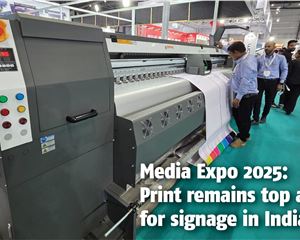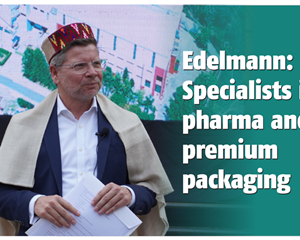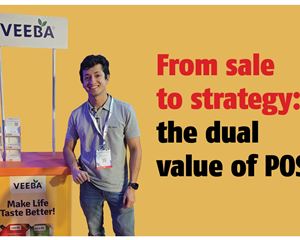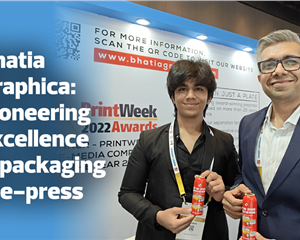Ramya Reprographic: A blueprint for hard work
R Narendra, managing director of Ramya Reprographic talks about how he rebuilt company after a major setback. A PrintWeek case-study
14 Jul 2021 | By PrintWeek Team
In 2007, Ramya Reprographic produced Volvo calendars for one of its clients Shilahar Associates. It was the company’s biggest order until then. Not just for the number of units it had to produce but also in terms of arranging raw-materials and coordinating logistics. Shipping in several quantities across different parts of India was a mammoth task. Challenge accepted. Challenge achieved.
This print project set the tone for the future of Ramya Reprographic. One that was full of ambition, enthusiasm and total commitment to its customers.
This is today. In 2021.
1995. That’s when Ramya Reprographic was born. Managing director R Narendra’s father B Rama Reddy’s planning and wisdom played a huge role in Ramya Reprographic’s growth story. Trusting the intuitions of his son to form the company was a part of this wisdom.
“The expansion phases in the past 26 years have had the same effect on me. Every time I would move into my new office I would experience the same feeling of goosebumps and butterflies in my stomach,” says Narendra.
If Narendra’s father stood as the rock around which he moulded himself, his wife C Bharathi has been a pillar of strength for the past 24 years. It enabled Narendra to take charge of the business that was growing multi-fold. Today, his brain-child and creation after he received a diploma in printing has moved from operating at a modest pace to running every hour of the day, in order to meet the demands of the customers.
Necessary expansion
When PrintWeek visited Ramya Reprographic for the first time in 2010. They were contemplating a shift of their operations from the 28,000 sqft unit in Bommanahalli to a new 1,00,000 sqft unit three kilometres away. This was a move which was “more out of necessity” as the building in which the unit was housed was about to be demolished by the government authorities.
“The shift was not out of choice but for the lack of choice,” says Narendra. “We had limited days in hand to shift to new premises. We found a building that two brothers owned. It was too large for our needs at that point in time and requested the bothers to rent us half the building which was denied. With no alternative left in hand, we decided to shift to four times the bigger space. This also meant four times higher rental charges.”
Narendra feels that “At times, sudden shift or change can be hard to accept. We often tend to focus on the negative aspects of the change.” It resulted in a few of his main team members who decided to discontinue their journey with Ramya Reprographic.
“They believed it was not very intelligent of me to take such a huge leap. So, they decided to sail in different direction,” says Narendra. “Such changes can move you out of your comfort zone. There are ways to work it out if you do not become victims of the circumstances.”
To overcome the challenges Ramya Reprographic had to work harder, find bigger and better clientele and stretch its working days. “The right intentions are prerequisite to harness the power of enthusiasm, to build a willingness to adapt, to work sincerely and to remain committed to the goal,” says Narendra.
Power of technology
Ramya Reprographic was the first press to introduce four-colour printing with in-line coater in Bengaluru in 2005. It hasn’t looked back in terms of machine firepower since the first important investment in a brand-new Dominant four-colour machine in 2001. It followed a simple strategy for pre-press, press and post press. Being a commercial printer, it had no choice but to evolve with technology – and be on par with the competition.
“Smart technology comes with lots of solutions and adjustments through various brands of machines. During our initial growth itself, we kept adding latest machineries on the pre-press and press front,” says Narendra.
This thought process justifies having a combination of Komori and Heidelberg presses on its shopfloor. “It was part of our planned production strategies that we dedicated the Heidelberg presses for commercial printing and Komori presses for packaging printing. This allowed us in running both our commercial and packaging production units without much difficulty in terms of consistency, quality and time,” says Narendra.
Ramya Reprographic produces an average of four to five Pantone jobs at any given time. Like with the presses, the company has selected multiple workflow suites. Its selection is based on four components: integration with the MIS and RIP, a flexible workflow management system, a comprehensive pre-press automation package like Illustrator CC Version, Photoshop CC Version, CorelDraw 21 Version, Professional PDF, IMP (automated imposition and ganging software), Fujifilm’s XMF workflow for CTP, EFI Colour Server with Proofer to analyse the final job and tailored tools for production planning and finishing based upon the following printing segments: commercial, books, packaging and labels.

Hassle-free pre-press
In packaging jobs, pre-press for extended gamut is critical. Ramya Reprographic follows the Pantone Extended Gamut Guide to get a visual reference for printing Pantone colour in expanded gamut. “It helps designers and brand owners decide when to select extended gamut, CMYK or a spot colour for their packaging,” says Narendra.
Implementation of expanded gamut at the converter end requires a good toolset and for that EFI and Fujifilms’s XMF were some of the ideal solutions for the company. “Based on the printing process and substrate, EFI and XMF can calculate the optimum colour conversion to match the Pantone Extended Gamut Guide reference and implement this in the workflow. EFI, XMF and the Pantone Extended Gamut Guide are an ideal combination,” says Narendra.
The company went the conventional route when it came to post-press. It realised the importance of post-press technologies only when the packaging division was introduced. “We immediately shifted to the best post-press equipment which helped us to finish all the production activities in short time,” says Narendra.
Recently, the company invested in an EasyMatrix. This was because Ramya Reprographic was unable to meet the required number of punched sheets per day with 15 manual platen machines. “It was boon for us as all jobs are long-run and our operators are able to complete the production including make-ready sheets within 90 minutes at the most without much downtime,” says Narendra.
Multiple print collaterals Ramya Reprographic has a combination of offset and digital kit on its shopfloor. Digital printing requires no manual setup and is extremely effective for smaller quantity runs, according to Narendra.
He considers digital to be more cost-effective than offset printing for low volume projects.
“Digital printing is also a quick process, capable of completing projects on short notice. We started digital printing to compliment the commercial printing and to serve walk-in customers. In past 11 years the digital division has contributed in increasing our client base,” says Narendra
Digital printing has improved in terms of competitive print quality, the ability to customise each individual product produced with variable data, and the ability to print on-demand. Ramya Reprographic was quick and successful to adopt and invest in digital printing technology.
The company further extended its operation by diversifying the product range and getting into folding cartons. It was a part of Ramya Reprographic scaling up its operations. It grabbed the opportunity that came its way. Seeing the scope, the company invested in appropriate and latest machineries needed to gear-up the production.
“With mono-cartons Ramya Reprographic added another vertical to its existing business, which currently is fetching 10-12% of our total business,” says Narendra. “We have an in-house R&D division where we experiment with materials and designs. Through this we are able to provide solutions by doing a prototype of packaging designs.”
Research shows that most people retain information more effectively when information is delivered via printed material versus an online interface. Keeping this in mind, Ramya’s R&D department continually develops efficiencies through initiatives, training, and investment in creating new products and services.
“There has been a rise in global consumption of consumer goods, fuelling the demand for rigid plastic packaging. Ramya thoughtfully invested in rigid packaging to meet with the new market demands,” says Narendra.
On an average Ramya Reprographic has a run of 8000 sheets per hour. Most of the jobs are long-runs and on tight schedule. All departmental heads meet daily to assess their given targets.
It’s all about money
Many converters deploy unusual methods to finance their investments. Ramya Reprograhic has its own success mantra in terms of capital deployment for generating growth. It appointed Priyanka Reddy as its chief financial officer (CFO) in 2017. Until then it was “haphazardly” handling its finances and running the show with private finance and business loans.
“Our CFO invested her time and resources to carefully analyse our financial strength and weakness. She initiated major corrective actions, cleared off all high-interest loans and prioritised our financial commitments,” says Narendra. “Today, we are working only with professional bankers, have no major loans and also have secured our working capital.”
A lot of MSME packaging companies tend to have one or two large clients who give them 50-60 percent of their turnover and they tend to grow with the clients. Instead, what works for Ramya Reprographic are multiple verticals and multiple clients. “Every organisation has strategies and if one strategy is not profitable then they tend to shift to an alternative model. We have been successful catering to multiple clients and will continue doing the same ahead,” says Narendra.
Champion employees
Young Indians make a big part of Ramya’ Reprographic’s workforce. Narendra calls it a really big family with more than 500 members. “Most employees have been doing exceptionally good even under such difficult times. We thank and praise them,” says Narendra. “And those who have performed extraordinarily, we appreciated and honoured them with certificates, cash and other gifts.”
It is owing to the company’s employees that the rough past 12 months have seen Ramya Reprographic sail through in uncertain times and achieve 60% of its target.
The simple secret of making the employees feel a part of this family is by taking care of their wellbeing. Ramya Reprographic’s management is connected to its staff members. The departmental heads see to it that each team member is doing well mentally, physically and financially.
“We offer one-to-one counselling to staff members who might suffer from anxiety or stress-related issues,” says Narendra. “We keep the health and well-being of our employees as our top priority.”
The priority of the wellbeing of employees wasn’t compromised even during the difficult time period when the pandemic had begun. The company firmly stood by its motto of health is wealth which is apt in the current circumstances.
“Since the beginning of Covid-19 pandemic every staff member of our company has been provided with an immunity drink and vitamin tablets every day,” says Narendra. “We wanted to ensure that our staff members remain healthy and Covid-19 free. It enabled us to operate like in pre-Covid-19 days without many difficulties.”

Past 12 months
Since the pandemic, commercial printing has witnessed a major drop. However, Narendra feels that the packaging industry will hit higher notes in the coming years. He also feels that the unprecedented price hike of raw materials was always a matter of concern; not just in 2020 or 2021. “The current circumstances are paving the way for tougher terrains and to keep the ball rolling will be challenging. We are maintaining our equilibrium by negotiating with our suppliers and clients, checking on wastage of raw materials and most importantly maintaining quality on all deliverables.”
The Covid-19 pandemic created disruption in normal life but also provided a steep learning curve for Ramya Reprographic to be more resilient and prepared for the future. “When I look back, it’s astounding to see what we all have overcome together and the progress we’ve made since the onset of the pandemic,” says Narendra.
The B2B nature of the print business is a challenge. Large share of company’s jobs are B2B. It became supplier to many clients and therefore operated from a financial space of very narrow margins. Luckily, says Narendra, it also had B2C clients who kept returning with repeat orders.
“Every industry is shifting to digital platforms to reach their customers. And since Covid-19, we have seen more and more clients opting for online services,” says Narendra. “Ramya had a very traditional marketing approach. Slowly but steadily, we are in the process of battling it out by planning our digital and online presence to reach out to more direct customers.”
Indian print industry
According to Narendra, as the new technology emerges and becomes more accessible, the power that was once in the hands of large corporations is now in the hands of the skilled individual.
Having said that, the major challenges for printing industry are digitisation trends, declining demands from industries like banking, advertising and postal services where digital channels have taken over. Price pressures with declining demand and increasing raw-material costs also hit the margins of printing businesses.
“Printing industry needs to acknowledge the fact that digital disruption is here to stay and we need to address these challenges. Printers have to find remunerative ways to connect print and digital technology in ways that can complement each other and lead to powerful results,” says Narendra.
When PrintWeek met Narendra in 2011-12 he had said one of the things Ramya Reprographic aimed to do was professionalise the old school print culture in Bengaluru. It was Narendra’s deep desire to see more learned and experienced professionals in the print industry.
“I miss seeing that even today. For example, in the medical sector, not everyone is a doctor. To become a doctor one has to learn, clear exams, get degree, do internship before practicing as a doctor. Likewise is engineering, law or finance,” says Narendra.
He wishes to see more people join print industry because they want to pursue a career in printing and not because they have no choice left. “Now we have multiple choices of machines and advanced technology to install in our presses but I still find one of the most challenging things in our industry is finding qualified, long-term and dedicated employees,” says Narendra.
Indian print industry poses a serious challenge between buyers and brands about recyclability of the packaging material. “Buyers and brands enthusiastically talk about using recycled material, but we see a different face when the time comes for implementation. We can’t blame them,” says Narendra.
There are two factors responsible for this. On the one hand, there is greater demand for virgin paper and manufacturers of virgin paper products are able to take advantage of economies of scale and pass on lower costs to the consumers. On the other hand, there is generally more processing involved in bringing to market recycled paper for consumer use. These are labour and time intensive processes, making the end recycled product more expensive than the virgin products.
“There is a whole lot of print waste on this planet. The basic raw material for producing recycled product is available in abundance,” says Narendra. “I wish that there are technologies developed to make the recycling process less expensive which in turn can see a better market and a higher consumer demand.”
R Narendra - At a glance

How do you unwind?
By exercising in the morning; watching a movie for 20 minutes in the evening; listening to motivational speakers and getting connected to my inner-self through prayers.
One activity you love…
Time spent in the gym.
Favourite films…
Bahubali, Madam Chief Minister, Chak de India and MS Dhoni: The Untold Story.
Once the pandemic is over, where will you vacation to?
I wish to take my parents to a few pilgrimage places.
Favourite snack…
Threptin biscuits.
Favourite book…
The Secret by Rhonda Byrne.
Favourite sports person…
MS Dhoni for his calmness and leadership skills and Mike Tyson for his aggressive and fearless attitude.
An international print factory you visited which is a must see…
GT Production in Germany.
One print factory (other than Ramya) in Bengaluru you love…
Escee Enterprises for how the office is laid out.
Who is on your speed dial…
My family.
A lesson you have learnt from your team member…
To be patient.
One phrase, you utter at least once a day…
Don’t give up!












 See All
See All